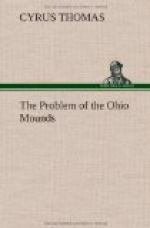It is all-important to bear in mind the fact that when this tradition was first made known, and the mounds mentioned were attributed to this people, these ancient works were almost unknown to the investigating minds of the country. This forbids the supposition that the tradition was warped or shaped to fit a theory in regard to the origin of these antiquities.
Following the tradition it is fair to conclude, notwithstanding the fact that Heckewelder interpreted “Namaesi Sipu” by Mississippi, that the principal seats of this tribe or nation were in the region of the Ohio and the western slope of the Allegheny Mountains, and hence it is not wholly a gratuitous supposition to believe they were the authors of some of the principal ancient works of eastern Ohio (including those of the Scioto Valley) and the western part of West Virginia. Moreover, there is the statement by Haywood, already referred to, that the Cherokees had a tradition that in former times they dwelt on the Ohio and built mounds.
These data, though slender, when combined with the apparent similarity between the name Tallegwi and Cherokee or Chellakee, and the character of the works and traditions of the latter, furnish some ground for assuming that the two were one and the same people. But this assumption necessitates the further inference that the pressure which drove them southward is to be attributed to some other people than the Iroquois as known to history, as this movement must have taken place previous to the time the latter attained their ascendancy. It is probable that Mr. Hale is correct in deciding that the “Namaesi Sipu” of the tradition was not the Mississippi. [Footnote: Am. Antiquarian, vol. 5, 1883, p. 117.] His suggestion that it was that portion of the great river of the North (the St. Lawrence) which connects Lake Huron with Lake Erie, seems also to be more in conformity with the tradition and other data than any other which has been offered. If this supposition is accepted it would lead to the inference that the Talamatau, the people who joined the Delawares in their war on the Tallegwi, were Hurons or Huron-Iroquois previous to separation. That the reader may have the benefit of Mr. Hale’s views on this question, the following quotation from the article mentioned is given:
The country from which the Lenape migrated was Shinaki, the “land of fir trees,” not in the West but in the far North, evidently the woody region north of Lake Superior. The people who joined them in the war against the Allighewi (or Tallegwi, as they are called in this record), were the Talamatan, a name meaning “not of themselves,” whom Mr. Squier identities with the Hurons, and no doubt correctly, if we understand by this name the Huron-Iroquois people, as they existed before their separation. The river which they crossed was the Messusipu, the Great River, beyond which the Tallegwi were found “possessing the East.” That this river was not our Mississippi is evident from the fact that




